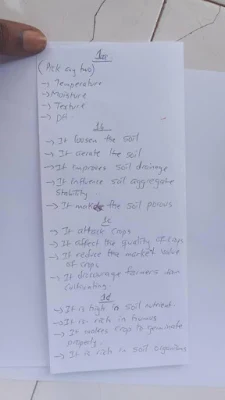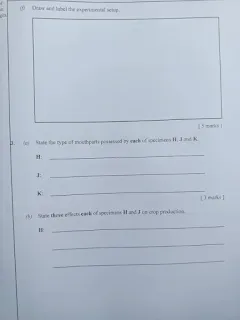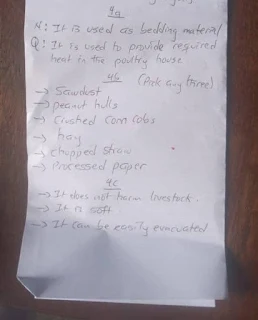WAEC AGRICULTURAL SCIENCE PRACTICAL ANSWERS
=====================
(1a)
(Pick any two)
(i) temperature
(ii) moisture
(iii) texture
(iv) pH
(1b)
(i) Helps to improve soil structure and granulation.
(ii) They help to also improve the aeration of the soil.
(iii) They help to decompose organic materials in the soil to form humus.
(iv) They improve soil water percolation or drainage.
(v) They also increase the collocidal properties of the soil
(1c)
(i) it attack crops
(ii) it affect the quality of crops
(iii) it reduce the market value of crops
(iv) it Discourage farmers from cultivation
(1d)
(i) it is high in soil nutrients
(ii) it is rich in humus
(iii) it makes crop to germinate properly
(iv) it is rich in soil organism
=====================
(2a)
E - They are used to provide drinking water to animals or livestock on farm.
F - Usually found in a barn or stable from which cattle, sheep or any animal feed.
G - A device use for testing egg while they are incubating, to determine if they are viable or not.
H -
2. (a)
- SPECIMEN E: is a container used for providing water to animals like cows,horses etc
- SPECIMEN F: is a container used for holding animal feed, usually for animals like cattle, pigs etc
-SPECIMEN G: An egg candler is a device used to check the quality of eggs.
- SPECIMEN H: is a tool used to collect samples of aquatic or semi-aquatic organisms.
=====================
3a)
Specimen I (Sugarcane): Saccharum officinarum
Specimen J (Pineapple fruit): Ananas comosus
Specimen K (Ginger): Zingiber officinale
3b)
Specimen I (Sugarcane): lThe planting material for propagating sugarcane is typically the stem sections or stalks of mature sugarcane plants.
Specimen J (Pineapple fruit): The crown, which consists of the leaves and a small portion of the fruit, is the planting material used for propagating pineapple.
Specimen K (Ginger): The planting material for propagating ginger is the rhizome
=============================
4a)
Specimen N:
(PICK ANY ONE)
(i) It serve as an excellent bedding material for poultry houses.
(ii) It can be used as litter on the floor of the poultry house.
(iii) Wood shavings make suitable nesting material for poultry.
(iv) Wood shavings can be used as an insulating material in the walls or ceiling of the poultry house.
Specimen Q:
(PICK ANY ONE)
(i) It can be used as a source of heat in poultry houses.
(ii) It can be used to repel insects and pests in a poultry house.
(iii) Using specimen Q in the poultry house, can help minimize and control foul smells.
(iv) It can be used for brooding newly hatched chicks.
(4b)
(PICK ANY THREE)
(i) Chopped straw
(ii) Shredded Newspaper
(iii) Sawdust
(iv) Sand
(v) Hay
(vi) Coconut Fiber
(vii) Corn cobs
(4c)
(PICK ANY THREE)
(i) Specimen N has a higher absorbency compared to Specimen M.
(ii) Specimen N provides a better cushioning effect than M.
(iii) Specimen N allows for better airflow within the deep litter bedding.
(iv) Specimen M tends to generate more dust particles compared to Specimen N.
(v) Specimen N tend to last longer in the deep litter bedding than M.
(vi) Specimen N are often more cost-effective compared to Specimen M.
(4di)
(PICK ANY TWO)
(i) The chicks will try to regulate their body temperature by drinking more water when they feel hot.
(ii) They may huddle together or seek out cooler areas in the brooder house.
(iii) Chicks may become less active.
(iv) Chicks may spread their wings away from their bodies to increase heat dissipation.
(v) The chicks may open their beaks and breathe rapidly to increase air circulation and cool down their bodies.
(vi) Chicks may vocalize more when they are subjected to excessive heat.
(vii) The chicks may reduce their food intake.
(4dii)
(PICK ANY )
(i) They may huddle together in a tight group to conserve body heat.
(ii) Chicks may become more active and move around the brooder house.
(iii) The chicks may shiver to try and warm up.
(iv) The chicks may reduce their feed intake and water consumption.
(v) The Chicks may respond by fluffing up their feathers.
(4e)
(PICK ANY THREE)
(i) Specimen Q provide a localized heat source within the poultry house.
(ii) Using specimen Q can be more energy-efficient compared to other heating methods, as th charcoal burns slowly and can provide a longer-lasting heat source without frequent refueling
(iii) Charcoal combustion produces dry heat, which helps reduce the moisture content in the poultry house.
(iv) Charcoal combustion generates minimal smoke and fewer emissions compared to other fuel sources.
(v) It is generally an affordable fuel option, making it a cost-effective choice for heating poultry houses












